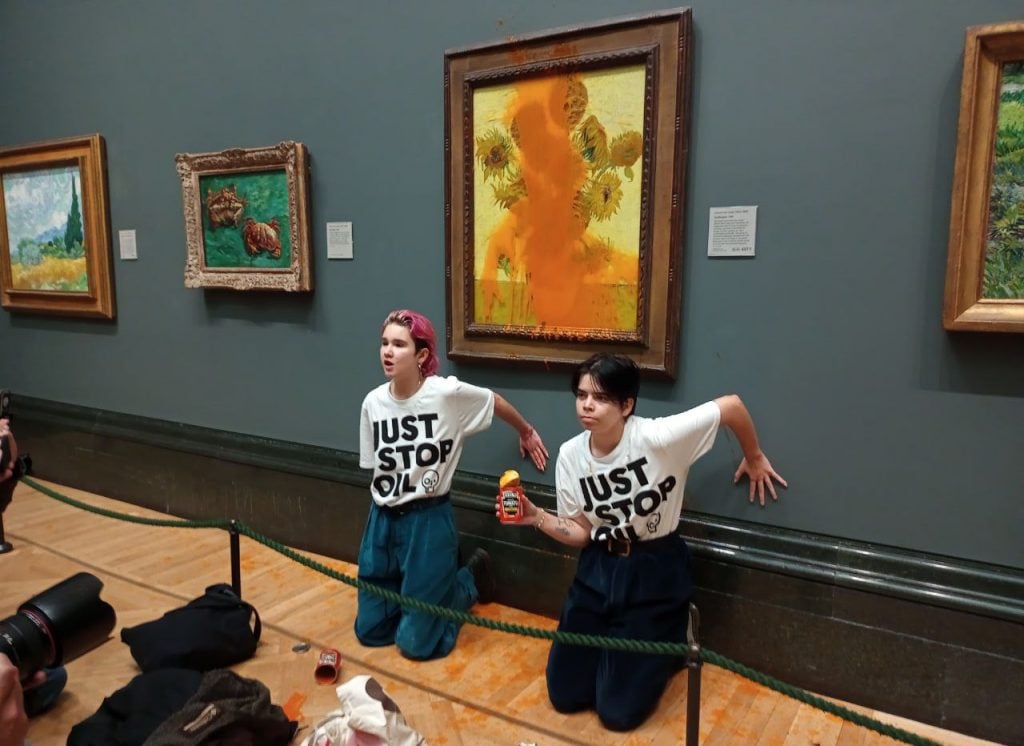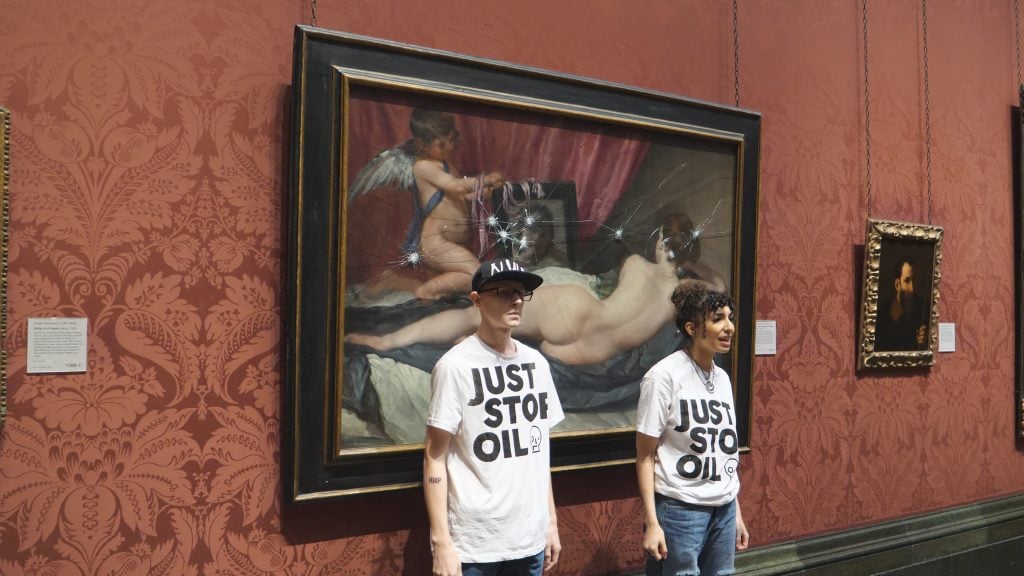Museums & Institutions
London’s National Gallery Restricts Liquids and Big Bags Amid Climate Protests
A Van Gogh painting at the museum was most recently targeted by activists.

A Van Gogh painting at the museum was most recently targeted by activists.

Vivienne Chow

From October 18 onwards, the National Gallery in London is prohibiting liquids and big bags on its premises in a bid to step up security measures amid ongoing protests targeting its masterpieces, the museum announced.
The decision came just days after activist groups offered to meet at the museum, citing the recent five attacks on iconic paintings since July 2022, including two that have happened in the last two weeks. Works affected included Vincent van Gogh’s Sunflowers, currently on view as part of the exhibition “Van Gogh: Poets and Lovers.” The work was most recently targeted by three Just Stop Oil activists who threw soup over the work as well as another 1889 Sunflowers canvas, on loan for the exhibition from the Philadelphia Museum of Art. Other works that have been targeted include John Constable’s The Hay Wain and Velázquez’s Rokeby Venus.
“Unfortunately, we have now reached a point where we have been forced to act to protect our visitors, staff and collection,” the U.K. public museum noted in a statement. “Such attacks have caused physical damage to the artworks, distress to visitors and staff alike, and disruption to our mission to ensure great art is available for everyone, everywhere to enjoy.”

Climate protesters hold a demonstration as they throw cans of tomato soup at Vincent van Gogh’s Sunflowers at the National Gallery in London, United Kingdom, 2022. Photo: Just Stop Oil / Handout / Anadolu Agency via Getty Images.
The new security measures will be in place from Friday, 10 a.m. onwards. No liquids can be brought into the museum, but exemptions are made for baby formula, expressed milk, and prescription medicines.
Visitors are urged to bring “minimal items,” meaning no large bags. They will have to go pass the walk-through metal detectors installed at all doors. Their bags and rucksacks will also be inspected at the entrance. It is expected that it will take more time to enter the museum.
“The collection we hold is irreplaceable and with each attack we have been forced to consider putting more barriers between the people and their artworks to preserve these fragile objects for future generations,” the museum noted, apologizing for the inconvenience caused to visitors. “But we hope that they understand why it is necessary for us to do this.”
The National Gallery’s decision came just days after its director, Gabriele Finaldi, joined fellow museum directors including the V&A Museum’s Tristram Hunt and Nicholas Cullinan of the British Museum in an open letter pleading with climate protestors to stop targeting their art.
“These attacks have to stop,” the National Museum Directors’ Council wrote in the letter published on October 11. These protests “are hugely damaging to the reputation of U.K. museums,” they noted, adding that it caused a great deal of stress to museum employees and visitors who no longer felt safe going to museums.
“[T]hese demonstrations now need to be taken away from our museums and galleries so that they can continue to provide light and solace to all.”

Two Just Stop Oil activists have been arrested for criminal damage to the glass protecting a Diego Velázquez painting at the National Gallery. Photo courtesy of Just Stop Oil
On Tuesday, activists groups Just Stop Oil and Youth Demand responded to the letter, offering to meet with museum directors next week at the National Gallery. “We have action-takers who have risked liberty to call for an end to oil and gas that would love to speak with Dr. Gabriele Finaldi. We’ll leave the soup at home,” the groups wrote. It is uncertain if such a meeting will take place. Artnet News has reached out to the National Gallery for comment.
Since 2022, masterpieces housed in top museums around the world have become targets of climate activists, who have been hurling food at and/or gluing themselves to the work. Works affected range from Vermeer’s Girl with a Pearl Earring at the Mauritshuis museum in the Hague to Leonardo da Vinci’s Mona Lisa at the Louvre.
The three Just Stop Oil activists who hurled soup at the Van Gogh paintings were arrested on September 27. Their action came as two protesters from the group, Phoebe Plummer, 23, and Anna Holland, 22, were sentenced to jail for two years and 10 months respectively. Plummer and Holland’s action was backed by an open letter signed by visual artists and other creatives who deemed the act a work of art itself.